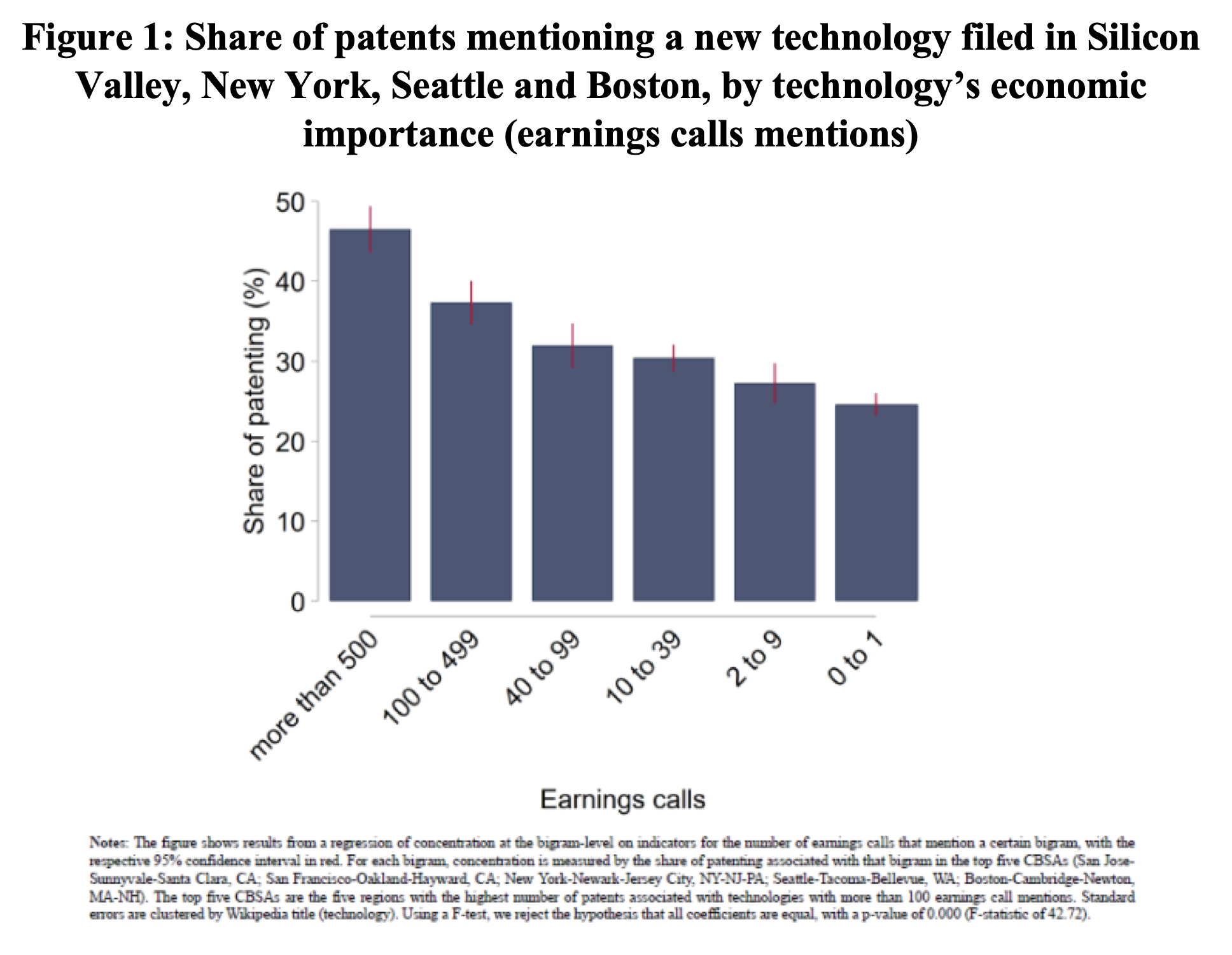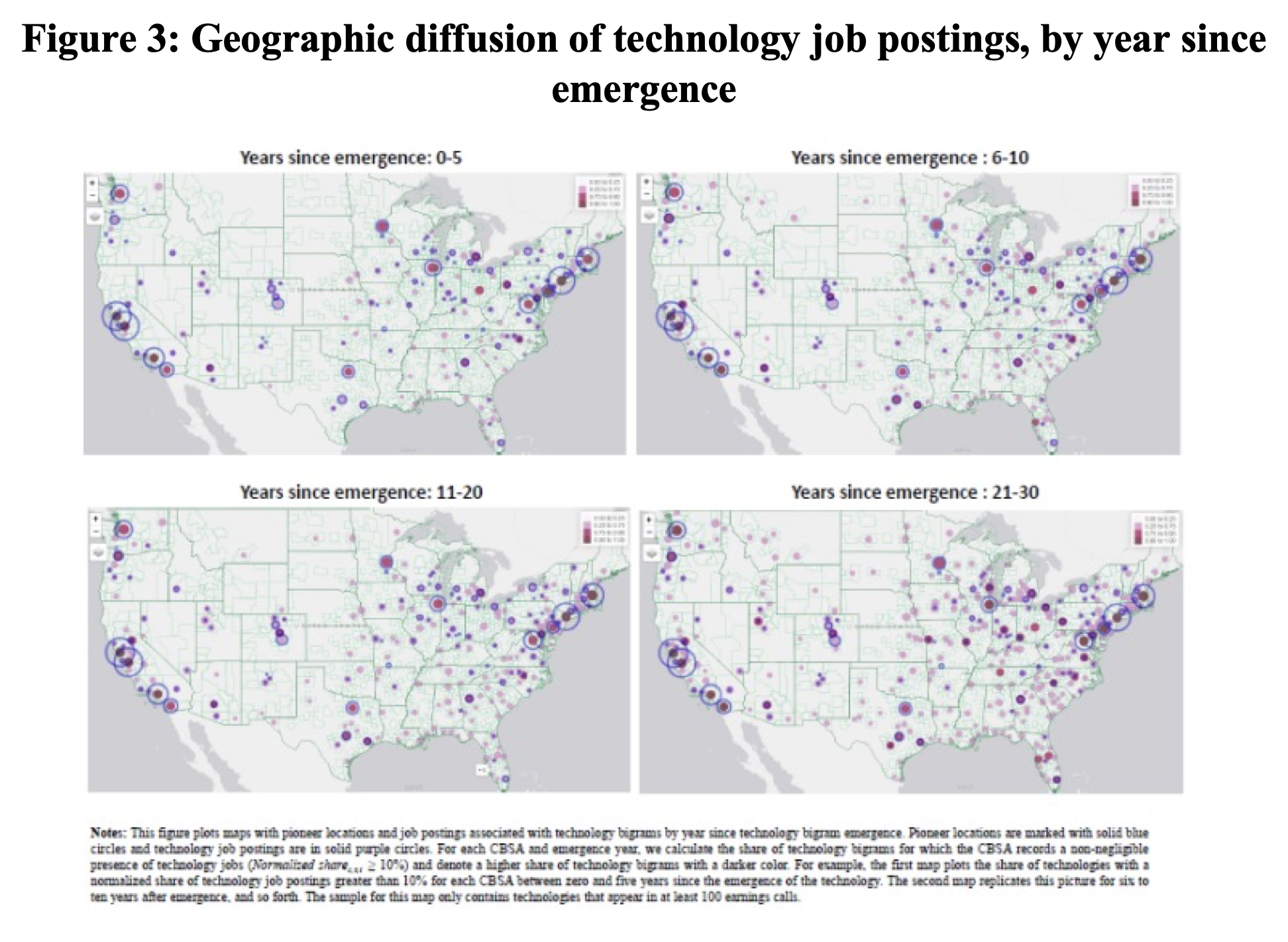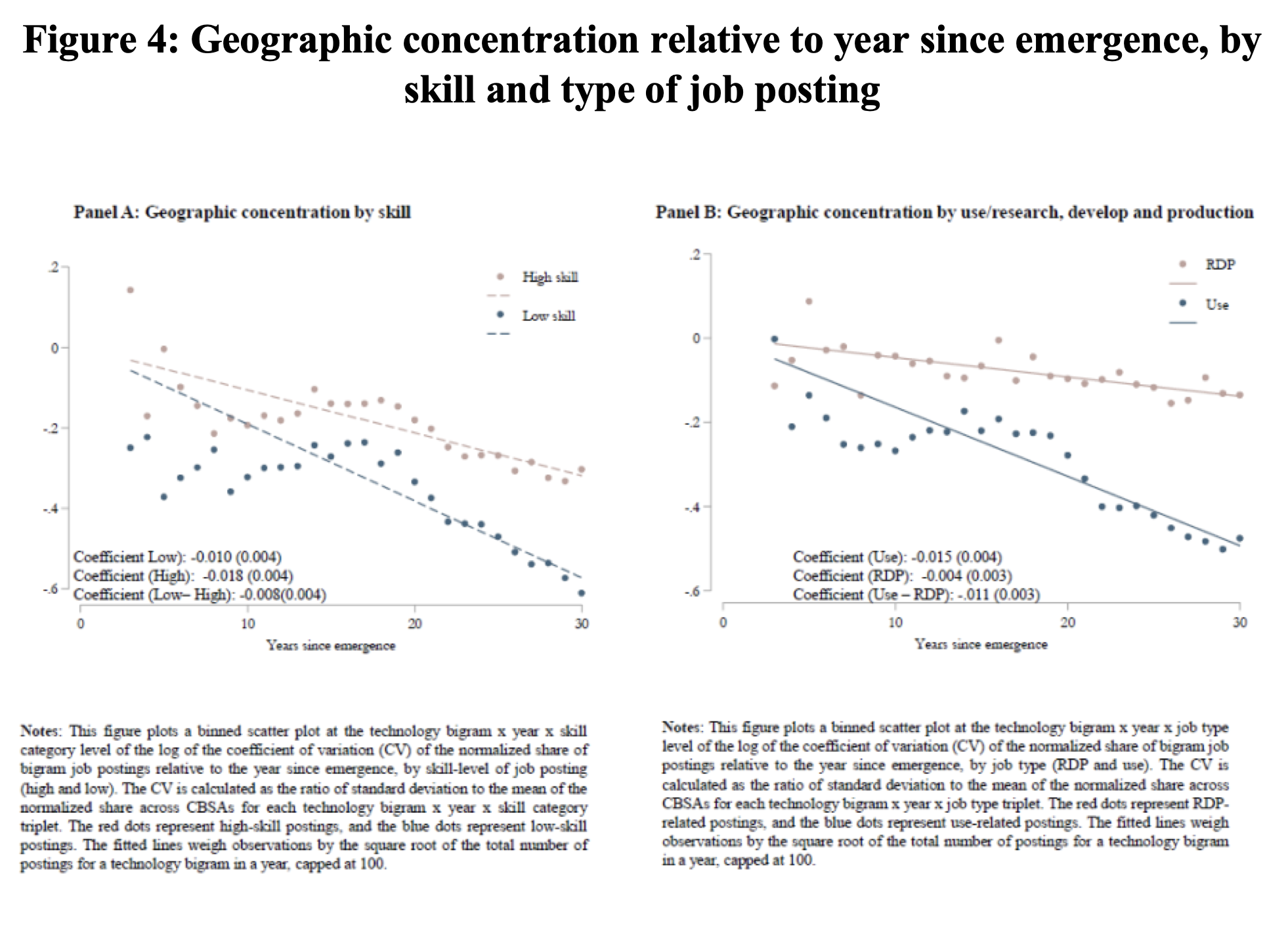New technologies appear to yield long-lasting benefits for the pioneer locations where they were originally developed.
Do technology-enabled jobs spread beyond college graduates? Do technology jobs spread outside Silicon Valley? In our new INET working paper, we use the full text of millions of patents and job postings and hundreds of thousands of earnings conference calls to make progress on these questions. We develop a flexible methodology that allows us to determine which (sets of) technological innovations most affected businesses over the past two decades, trace these back to the locations and firms where they emerged, and track their diffusion through regions, occupations, and industries over time. We then use our newly created data to establish key stylized facts about the development and diffusion of new technologies across space and skill levels.
The first step of our analysis is to develop a methodology for systematically identifying one-, two-, and three-word phrases (unigrams, bigrams, and trigrams) associated with new technologies through a series of systematic rules, whose robustness we verify through various diagnostic tests. To this end, we intersect information from multiple large corpora of text. First, we use the full text of U.S. patents with application years between 1976 and 2014 to isolate phrases that appear in multiple patents but did not exist before 1970. That is, we isolate new language specific to influential innovations made in the past 40 years. Second, we search for these phrases in Wikipedia to identify which of these new phrases are primarily associated with pages describing new technologies, as opposed to newly recognized problems (such as “climate change”) or new management terms (such as “performance metrics”). This procedure identifies 1,899 new technology phrases, which we can group into 1,286 unique Wikipedia pages describing new technologies. We refer to these groups of new technology phrases as “technologies.”
After establishing our list of new technologies, we then identify patents and job postings that mention these technologies. We use patent inventor addresses to identify the locations where each of the technologies was developed and patent application years to pinpoint the year in which the technology experienced the first large acceleration in patent references (its “emergence year”). We then cross-reference our list of technology phrases with the full text of online job postings to identify 51 million jobs advertised between 2010 and 2019 that mention these new technologies. These granular data uniquely allow us to track the spread of new technologies along a dimension of crucial importance to policymakers: jobs. In particular, we examine the evolution of the number, location, and skill requirements of job postings associated with these new technologies.
In a final step, we use the full text of earnings conference calls held by listed firms between 2002 and 2019 to flag those new technologies that are frequently referenced in these important conversations between firm executives and investors. The most frequently mentioned technologies include “cloud computing,” “smartphone,” and “machine learning.”
Strikingly, the right tail of technologies with the most earnings call mentions also accounts for the lion’s share of the variation in our job postings and patenting data. For example, the 276 technologies with more than 100 mentions in earnings calls (the top 22 percent) also appear in 39 million job postings (or about 77 percent of all job postings mentioning any new technology), and 33.1% of patents granted by the U.S. Patent and Trademark Office (USPTO) with application years between 1976 and 2014. In this sense, the innovations that feature prominently in managers’ discussions also have the largest impact on patents and job postings. We therefore pay special attention to these most economically impactful technologies throughout our analysis.
Our key results are as follows. First, the locations where new technologies are developed are geographically highly concentrated. This concentration is particularly pronounced for the most economically impactful technologies: 33.3% of patents mentioning any new technology and 42.1% of patents mentioning a new technology with more than 100 mentions in earnings calls emerge from just five urban areas: San Jose, San Francisco, New York, Seattle, and Boston.
Based on early patenting activity around the time of each technology’s emergence year, we identify which urban areas housed most early patenting for each of our new technologies. We term these urban areas “pioneer locations.” Again, these pioneer locations for new technologies are highly concentrated, particularly so for the most economically impactful new technologies. Collectively, 56.3% of these most impactful technologies come from just two U.S. locations, Silicon Valley and the Northeast Corridor. (Locations in California collectively host a remarkable 41.0% of pioneer locations of these most impactful new technologies.) This extreme concentration is particularly important because new technologies alter the composition of the local job postings in their pioneer locations for several decades, as we show below. See Figures 1 and 2.


Second, despite this highly skewed initial distribution of pioneer locations, as technologies mature and the number of new jobs related to them grows, they gradually spread geographically. Our favored measure of geographic concentration, the coefficient of variation of the share of jobs associated with a new technology across the 917 core-based statistical areas (CBSAs) in the U.S., falls by 18.5% in the first decade after its emergence. Nevertheless, the implied years to full dispersion across CBSAs is more than 50 years, well beyond the horizon of most policymakers. See Figure 3.

Third, while initial hiring is heavily biased towards high-skilled jobs, the mean required skill level of the jobs associated with new technologies declines over time, reflecting a broadening of the types of jobs that adopt a given technology. Specifically, we estimate that, in the year of the average technology’s emergence, 57.1% of the initial jobs relating to this new technology require a college degree – a substantial skill bias relative to 30.3% of respondents in the 2015 ACS that hold one. This gap declines by 0.23 percentage points per year, so that 30 years after a technology’s emergence year, on average about 50.2% of job postings relating to it still require a college degree.
Fourth, low-skill jobs associated with a given technology spread out across space significantly faster than high-skill jobs, which tend to remain concentrated for long periods of time within the pioneer locations that originally developed the technology.
A key implication of these patterns is that new technologies appear to yield long-lasting benefits for the pioneer locations where they were originally developed. These locations host a disproportionate share of high-skilled jobs relating to these new technologies for about four decades after their year of emergence. In short, this concentration of innovation in a handful of urban centers engenders large and persistent regional disparities in economic opportunity, giving a handful of U.S. locations a lasting advantage in high-skill job postings.
To shed light on the mechanisms underlying these patterns, we study the context in which the new technology is mentioned within a given job posting. We find that much of the regional spread of new technologies is driven by low-skill jobs associated with their use, whereas jobs related to their research, development, and production (RDP) remain persistently concentrated in and around their pioneer locations. That is, pioneer locations that initially developed a technology retain a long-term advantage because they retain the technology’s RDP for long periods of time. See Figure 4.
We also show evidence to suggest that some of the observed skill broadening of new technologies is driven by standardization that allows for the use of these technologies by lower-skill workers as the technology matures. By contrast, training and experience with the new technology do not appear to be major drivers of this process.










